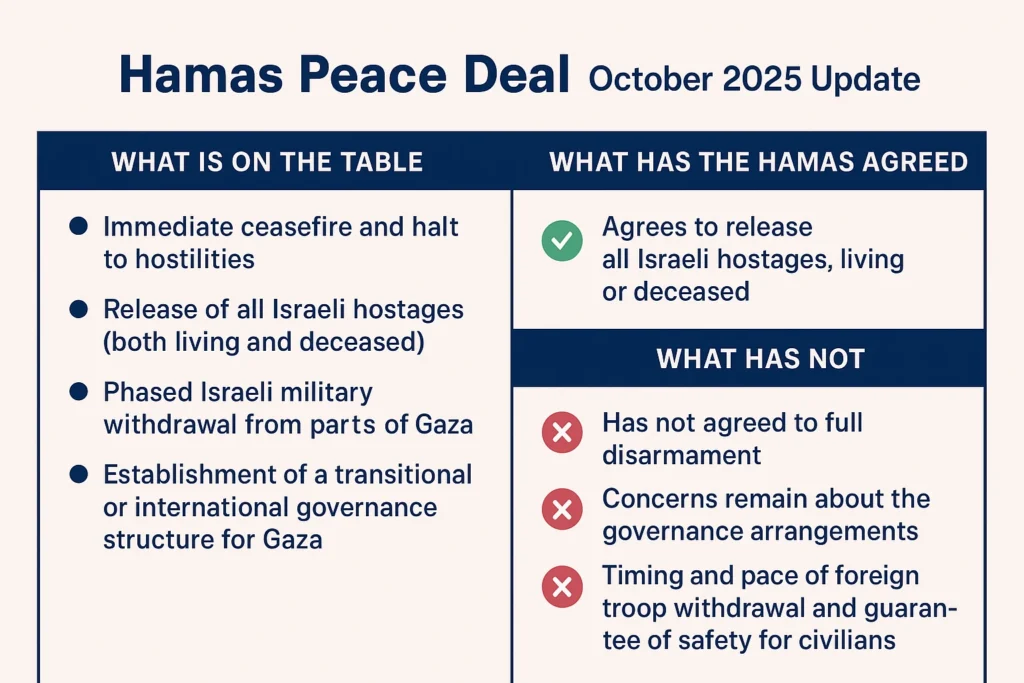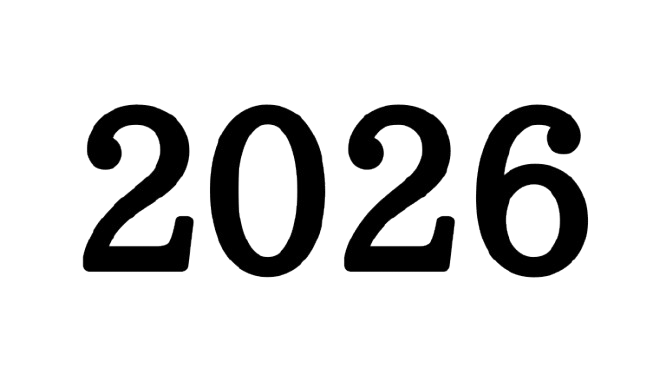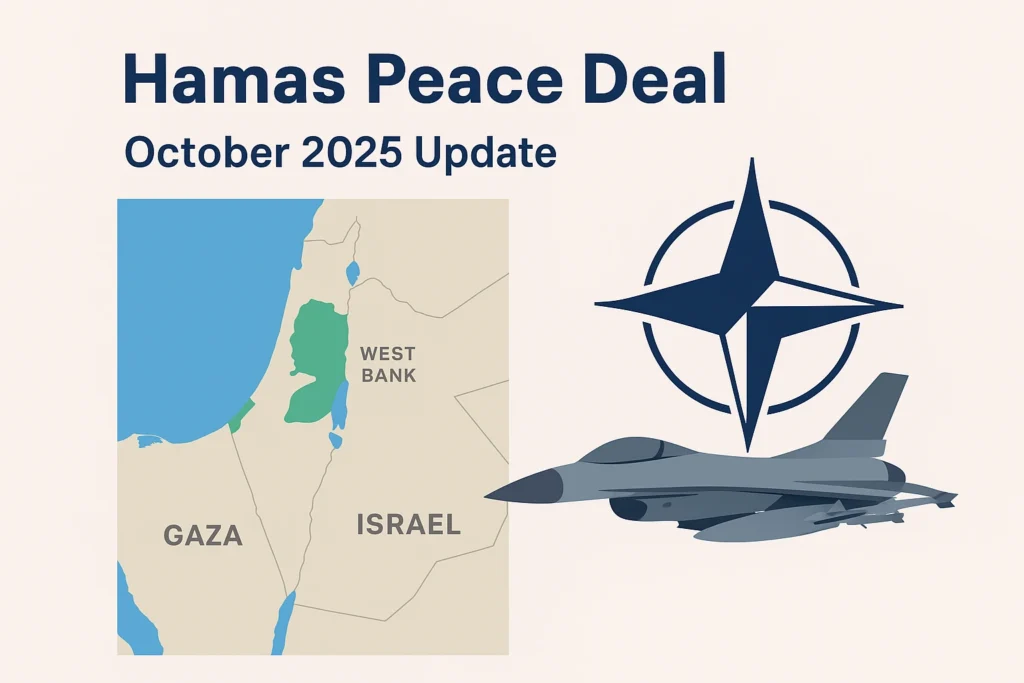Introduction
In October 2025, after nearly two years of intense conflict, a new peace proposal has stirred international attention over the Israel-Hamas war centered in Gaza. Brokered by the United States and supported by mediators like Qatar and Egypt, the plan proposes a ceasefire, hostage exchanges, and governance changes for Gaza. Hamas has shown signs of acceptance for some parts, but major disagreements remain. This article Hamas Peace Deal, breaks down the facts, what both sides have agreed or rejected, and what to watch moving forward.
Key Elements of the U.S.-Brokered Peace Proposal
On September 29, 2025, President Donald Trump unveiled a 20-point peace plan aimed at ending the war in Gaza. Key components include:
- An immediate ceasefire and halt to hostilities.
- The release of all Israeli hostages (both living and deceased) held by Hamas and other armed groups.
- A phased Israeli military withdrawal from parts of Gaza under the deal.
- Hamas’ disarmament, or at least giving up many of its military capabilities.
- Establishment of a transitional or international governance structure for Gaza, to oversee implementation.
- Pregnancy of humanitarian aid immediate and uninterrupted access.
- A deadline: Hamas was given until Sunday, 6:00 p.m. Eastern Time (Washington, D.C.) to accept the deal or face what U.S. officials called “severe consequences.”
READ MORE: Russian Aircraft Violations of NATO Airspace 2025

What Hamas Has Agreed To And What It Has Not
What Hamas Has Agreed
- On October 3, 2025, Hamas announced it agrees to release all Israeli hostages, living or deceased, under the terms of the proposed peace plan.
- Hamas has expressed acceptance of some elements of the proposal. They have not fully rejected the plan, and have conditioned some acceptance on further negotiation.
What Hamas Has Not Accepted or Where Disagreements Remain
- Hamas has not agreed to full disarmament. There is resistance to surrendering all military capabilities.
- Concerns remain about the governance arrangements. Hamas demands Palestinian participation in future governance decisions and insists on protections, particularly for civilian rights in Gaza, before agreeing to oversight terms.
- The timing and pace of foreign troop withdrawal and the guarantee of safety for civilians are also under negotiation. Hamas insists that Israeli forces must make credible commitments, including guaranteeing aid access.
READ MORE: Is the U.S Government Shut Down
Reactions from Israel, the U.S., and Other Mediators
- Israel under Prime Minister Benjamin Netanyahu has publicly accepted the proposal, with important (and possibly pre-negotiated) modifications. These modifications include security guarantees and conditions for withdrawal.
- The U.S. government, led by Trump, is applying diplomatic and public pressure on Hamas to accept the plan by the deadline. The U.S. has made clear that failure to accept could lead to harsher military action.
- Mediators like Qatar and Egypt are involved in negotiating finer points, especially around how the deal is implemented: when hostages are released, aid access, and what oversight structure would look like.
Humanitarian Context
- The war has caused extensive civilian suffering in Gaza, with widespread displacement, infrastructure destruction, and shortages of food, water, medical supplies. The humanitarian crisis remains a major argument driving support for a peace deal.
- For many families of hostages, the release proposal provides hope, but there are concerns about safety and conditions.
READ MORE: How Many Days Left for Trump Presidency?
Risk & Challenges Ahead
Even with the announced proposals, several major risks and obstacles could hinder implementation:
| Risk / Challenge | Explanation |
| Verification & Trust Issues | Ensuring both sides abide by terms will require strong verification mechanisms. Past ceasefires have broken down due to mistrust and allegations of violations. |
| Disarmament Disagreements | Hamas’ military wing is especially reluctant to disarm, and demands full guarantees for civilian safety. |
| Governance & Oversight Disputes | Dispute over who runs Gaza during a transition (international oversight vs local governance) remains unresolved. |
| Timeline Pressure | The U.S. deadline puts pressure on agreement quickly, potentially leading to rushed decisions. |
| Potential for Escalation | If Hamas rejects or is seen to delay acceptance, warnings of “severe consequences” heighten the risk of renewed large-scale military operations. |
What Happens If a Deal Is Rejected or Delayed
- If Hamas fails to accept by the deadline, Israel and the U.S. signal that military pressure could increase.
- Ongoing humanitarian suffering will likely worsen, especially in Gaza. Aid access may remain limited.
- International diplomatic relations may also shift: Arab nations and others are urging Hamas to accept, so a rejection could isolate Hamas further diplomatically.
What to Watch in the Coming Days
- Hamas’ official statement whether they fully accept, accept with amendments, or reject.
- Details of the hostages’ release timeline when, how, how many.
- Israeli military actions whether Israel begins withdrawal phases or holds positions.
- Foreign mediation efforts whether Qatar, Egypt etc. firm up oversight and governance terms.
- Humanitarian aid flow whether aid begins moving aggressively into Gaza as promised.
- International responses UN, U.S. allies, human rights organizations’ reaction to whatever agreement emerges.
FAQ
Has Hamas accepted the deal fully?
No. They have accepted certain aspects (like releasing all hostages) but have not agreed to full disarmament or the final governance structure.
What is the deadline Hamas is given?
Sunday at 6 p.m. Eastern Time on the coming weekend of early October 2025.
What does disarmament mean under the proposal?
It refers to giving up military capabilities, including potentially heavy weapons, rocket operations, and maintaining no organized military presence. The exact terms are under negotiation.
What happens if Hamas rejects the plan?
The U.S. and Israel have warned of “severe consequences,” which could mean escalation in military operations.
Conclusion
The October 2025 peace proposal represents one of the most serious frameworks yet for achieving an end to the Israel-Hamas conflict. Though it includes significant and humanitarian-focused steps such as ceasefire and hostages release, key sticking points remain: disarmament, governance, timing, and trust.
For this deal to transition from proposal to reality, both Hamas and Israel must navigate difficult diplomatic terrain. The path ahead is delicate, but given the human cost of continued conflict, many believe this may be their best chance yet.

